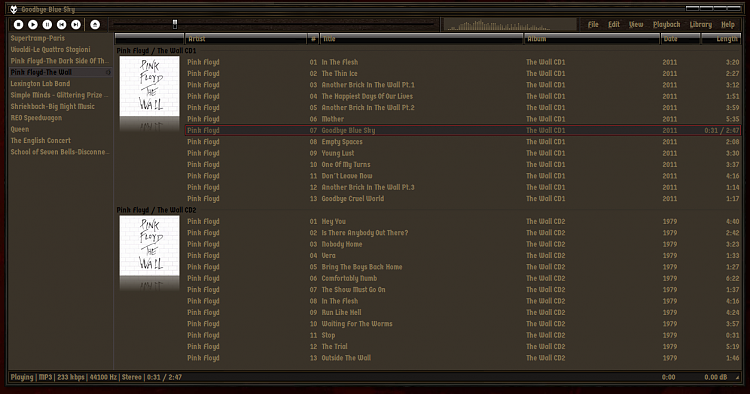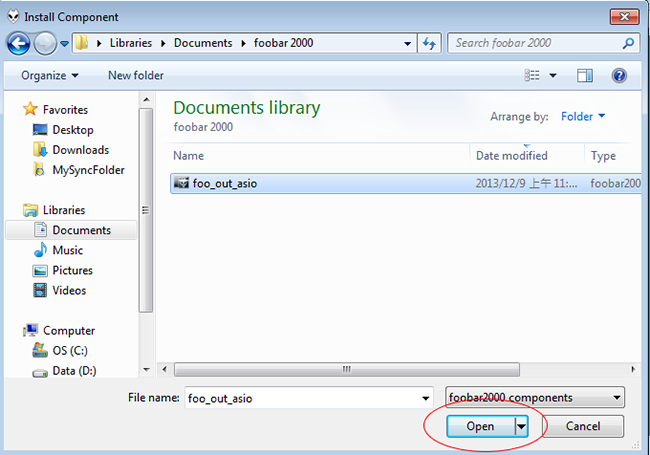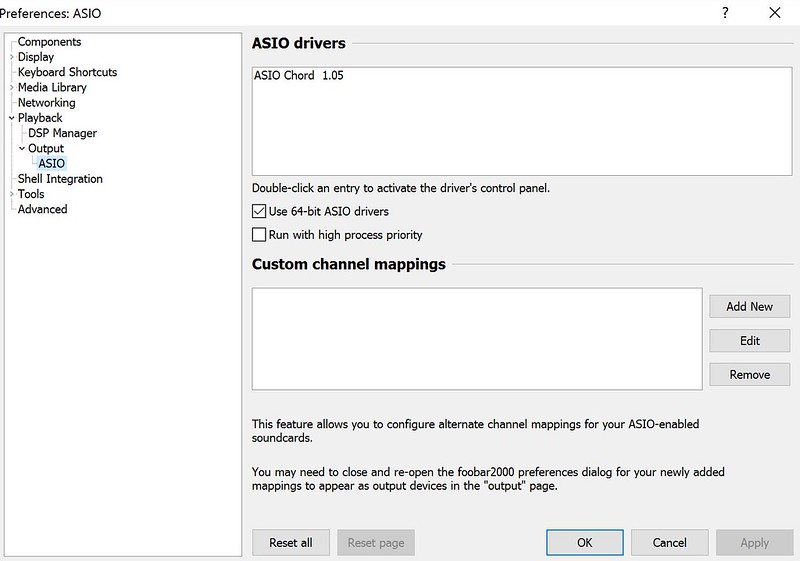- Foobar Asio Drivers
- Foobar Asio Driver App
- Foobar Asio Driver Software
- Foobar Asio Driver
- Foobar Asio Driver Windows 10
- Foobar Asio Driver Windows 10
| WASAPI output support | |
|---|---|
| Developer(s) | Peter Pawlowski |
| Repository | {{{repository}}} |
| Release information | |
| Initial release | {{{released}}} |
| Stable release | 3.3 (June 19, 2017) |
| Preview release | N/A |
| foobar2000 compatibility | |
| Minimum version | 1.1 |
| Maximum version | {{{foobar2000_maximum}}} |
| UI module(s) | N/A |
| Additional information | |
| Use | Output |
| License | {{{license}}} |
| Discussion thread | N/A |
The Windows Audio Session API (WASAPI) output support component allows you to play your music using WASAPI exclusive mode.

WASAPI is a new audio output method introduced in Windows Vista; among other things, it provides an exclusive mode that allows applications to take full control over soundcard's resources (muting any sounds played by other applications) and play unaltered bitstream without passing it through the Windows mixer.
The AQVOX USB ASIO Driver The comprehensive identification of the multiple problems caused by the operating systems and computer hardware made it possible to develop an ideal solution. Run ASIOProxyInstall-X.X.X.exe to install foodsdasio ASIO proxy driver. In foobar configure foodsdasio proxy by selecting appropriate DSD compatible ASIO driver, DSD playback method, PCM/DSD to DSD conversion method (if needed) and DSD samplerate for PCM/DSD to DSD conversion.
- 2WASAPI plug-in version 3.0
Differences between WASAPI and ASIO / Kernel Streaming from foobar2000 user’s perspective[edit]
- Requires Windows Vista or Windows 7 - not available on Windows XP or older.
- Works with more soundcards - contrary to e.g. ASIO, it doesn't require any special support from soundcard's manufacturer, other than providing a Windows Vista compatible driver.
- Guarantees muting of any other sounds played through the soundcard - with ASIO and KS, muting occurred with some soundcards but not with all of them; it was a side effect rather than a feature.
Foobar Asio Drivers
WASAPI plug-in version 3.0[edit]
Output modes: push and event-driven[edit]
As for the latest version of the component, two different output modes are available - push and event-driven; certain soundcards - especially USB devices - are known to cooperate better with the event-driven mode while certain other soundcards do not support the event-driven mode at all.
Sandbox[edit]
Unfortunately, WASAPI is affected by various bugs in both Windows mixer and soundcard drivers. To keep these from crashing foobar2000, all WASAPI access is now sandboxed in a separate process for better stability.
Buffer size tweaks[edit]
Please note that any buffer tweak options do not explicitly cause the specified buffer size to be used; if the specified value is outside the allowed range for your device, the nearest allowed value will be used.
See also[edit]
External links[edit]
- WASAPI output support (foo_out_wasapi) on foobar2000.org
- WASAPI on Wikipedia
Foobar Asio Driver App


| foobar2000 Preferences | |
|---|---|
Deprecated pages
| |
Output Device[edit]
Controls the physical device that played audio stream is sent to. Commonly available options include:
- Null Output - does nothing; useful mainly for development/testing purposes.
- DS : Primary Sound Driver - your system default DirectSound audio playback device as configured in Windows Sound control panel.
- DS : <device name> - a specific DirectSound audio playback device. What it says depends on what devices you have installed.
Additional output devices can be added using optional output components, such as foo_out_wasapi for WASAPI output (low-latency feed to a sound driver in exclusive mode, bypassing the Windows mixer).
Buffer Length[edit]

Foobar Asio Driver Software
To protect playback from glitches during heavy system load or file access lag, resource-heavy operations such as decoding and DSP are always performed ahead of currently heard sound (this is not unique to foobar2000, all or nearly all media players behave this way). This setting controls the distance between decoding/DSP and output.
- High buffer sizes offer stronger protection against glitches but introduce side effects such as long delay between changing DSP settings (eg. adjusting equalizer bands) and changes in sound output.
- Low buffer sizes allow faster responses to DSP configuration changes at cost of higher risk of stuttering during high system load / file access lag / etc.
WARNING: Setting too low buffer length may cause certain visualizations to stop working correctly. Use of buffer lengths below 500ms is not recommended.
Output Format[edit]
Controls the audio data format passed to the operating system / audio drivers / etc. You should refer to your soundcard's documentation to find the optimal setting; using bit depth higher than supported by your hardware might work but will not improve output audio quality in any way and may degrade performance.
Note that this option is not available with some output modes such as ASIO - ASIO architecture doesn't support variable data formats by design, the format that needs to be sent is determined by the driver.
Dither[edit]
This checkbox controls whether to add dither when playing audio that's encoded at a higher bit depth than the chosen output format.
Dither is quiet broadband noise which is added in a manner intended to mask quantization noise, which is the distortion which is sometimes audible when playing digital audio at a lower bit depth than the original. By exploiting a feature of human hearing—the ability to distinguish signal from background noise—dither preserves the higher bit-depth signal within the confines of the lower bit-depth format. This gives the signal greater dynamic range than the lower bit depth allows, and can be perceived as improved, smoother sound quality, but it always comes at the price of added background noise—which, when audible, sounds like tape hiss. However, dither can be 'shaped' to make it avoid lower frequencies, making it less audible to humans.
Dither uses extra CPU power, and generally isn't necessary. The signal in most recorded audio is well within the 96 dB limit of 16-bit, and the distortion introduced in 24-to-16-bit conversion is so quiet as to almost always be masked by the signal, at least for human hearing. Nevertheless, if your soundcard can only handle a maximum of 16-bit input, but you tend to play, at loud volume, 24-bit audio files with very quiet sections that have no background noise, then you may want to enable dither, because it can make those extreme quietest parts of the audio audible, with the addition of hiss.
Foobar Asio Driver
For a dramatic demonstration of the effect of dither, set the output format to 8-bit (if your soundcard supports it), and play an ordinary 16-bit audio file both with and without dither. The version with dither will have a fair amount of extra noise, but it will be substantially less fuzzy/gritty than the version without. This is an exaggerated demonstration, because for the average human listener, the distortion that occurs when reducing the depth to 8-bit is far more noticeable than that which occurs when down-converting to 16 or 24 bit.
Fading[edit]

This section appears when a DirectSound device is selected.
Without fading, transitions can be jarring when jumping from one track to the next, or when seeking within a track. This section allows this effect to be softened.
Foobar Asio Driver Windows 10
The sliders adjust the fade in and fade out values or the currently selected type of fade (pause & stop, seek within a track, manual track change, automatic track change). Arrow keys may allow the sliders to be adjusted with greater precision than a mouse or touch surface.
Foobar Asio Driver Windows 10
